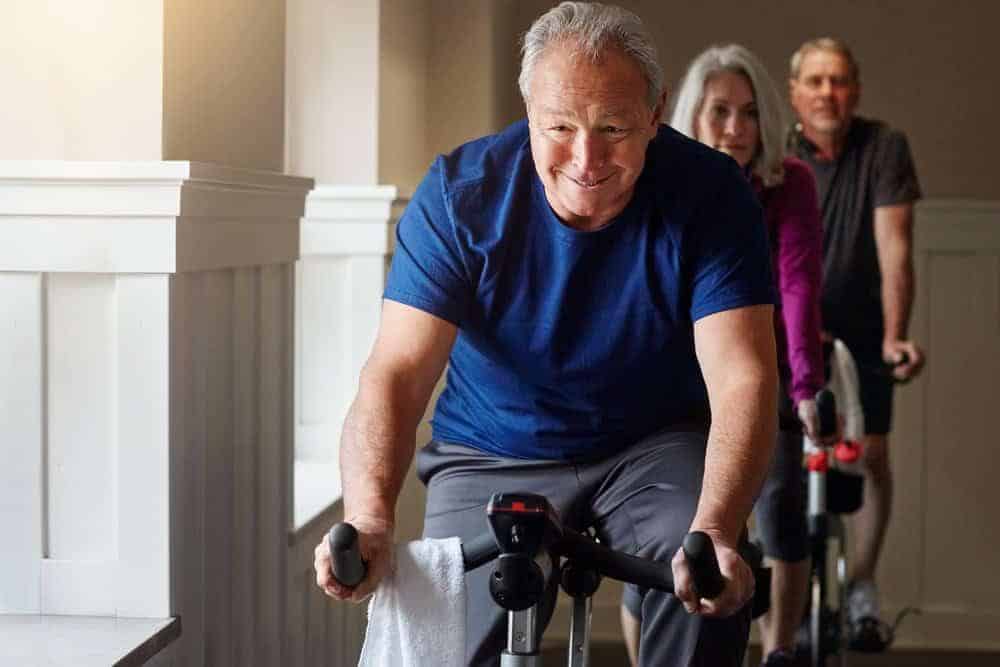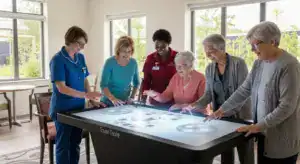Picture this: your loved one has just come out of surgery, and you hope they will be on their feet as soon as possible. Or they may be recovering from an injury or illness. Physical Therapy will be instrumental in their recovery as it aims to help your loved ones regain mobility.
Helping a loved one navigate their recovery journey can be overwhelming. The fear of whether they will regain total mobility, pain, and self-doubts can make their journey disastrous. However, physical therapists can help seniors overcome their fears and show them how to recover fully.
This article will explore why physical therapy is important, its fundamental goals, and how your loved one will benefit from it as part of their recovery regimen. We are here to help you if you are considering physical Therapy as a treatment option for your loved one or want to understand PT.

Understanding Physical Therapy
When your loved one participates in a senior’s rehabilitative program, they will work towards recovery. Physical therapy can help seniors strengthen their muscles, move better, and reduce the need for pain relief medications. Additionally, this program will play a crucial role in helping restore a senior’s body functionality and improve their quality of life.
Definition of Physical Therapy (PT)
Physical Therapy (physiotherapy) treats injuries, deformities, or diseases using various methods. A physiotherapist will help your loved one on their recovery journey, and they can achieve this using these methods:
- Massages
- Exercises
- Physical stimuli (cold, heat, ultrasound, or electrical currents)
PT for seniors usually prioritizes their desire to remain independent despite their medical conditions. This will help your loved one improve their mobility and prevent future injuries.
Goals of Physical Therapy
The main goals of physical therapy are to restore body functionality, relieve pain, increase a patient’s range of motion, strengthen muscles, and help people move better.
A physiotherapist helps patients improve their health by choosing better lifestyles.
The physiotherapy field is guided by several principles that include:
- Holistic Approach: When treating patients, physical therapists consider the whole person and not only the part requiring treatment. This ensures they address each patient’s psychological, social, and physical aspects.
- Functionality: Since physiotherapy’s primary goal is to rehabilitate function and mobility, a physical therapist will work with your loved one to enhance and restore their movements.
- Personalized care: Physiotherapists provide customized care to each parent, ensuring that your loved ones’ physical therapy care will be tailored to their specific goals and needs.
- Effective evidence-based care: A physical therapist bases treatment decisions on scientific research and follows adequate clinical trials.
- Prevention techniques: A physiotherapist will work with your loved one, emphasize the importance of injury prevention techniques, and educate patients on promoting their overall health.

Benefits of Physical Therapy for Seniors
As people age, they experience different physical changes, and physiotherapy is crucial in promoting their health. Whether your loved one is recovering from surgery, injury, or a debilitating illness, physical therapy will play a key role in their recovery. Some of its benefits include:
It helps in preventing scar tissue build-up
Scar tissue forms after surgery or an injury. It is vital to prevent this build-buildup, as it can cause tightness and pain in your loved one, preventing quick recovery.
Physical therapy helps your loved one prevent tissue buildup by incorporating manual techniques and stretching. Preventing tissue buildup ensures effective and smooth rehabilitation.
It helps Fix any faulty movements
Chronic pain after an injury or surgery can be debilitating, and this may lead to faulty movements. Pain, especially in joints, may cause a person to change their movements to reduce or avoid the pain. This change in movements can alter a person’s gait if not addressed on time.
A physiotherapist will help manage pain, ensuring your loved one retains their movement pattern.
Improving mobility and flexibility
During physical therapy, seniors perform stretching exercises, which help maintain their range of motion and flexibility and prevent injury.
A physical therapist designs exercises that address a senior’s specific needs. If your loved one needs more stretching exercises to help with their flexibility, you will find that their regimen will include them.
Some of these exercises include:
- Climbing stairs
- Walking
- Sitting on a chair
- Getting out of a chair

It helps enhance a senior’s strength
A physical therapist will design a customized exercise program for your loved one to help improve muscle strength, motion, and flexibility. These exercises help seniors maintain and regain their independence and perform their daily living activities (ADL).
PT helps in the Management of Chronic Health Conditions
PT can help manage chronic health conditions such as heart disease, stroke, or diabetes by providing a regimen that improves your loved one’s cardiovascular, endurance, and overall well-being.
It helps in strengthening muscles
Pt incorporates strengthening exercises, which mainly focus on strengthening muscles surrounding a patient’s joints, which helps reduce joint pains.
When your loved ones work on strengthening their muscles, they help reduce the strain surrounding the joints, which allows them to maintain their balance. Poor balance leads to falls, which can be fatal to most seniors as they result in more injuries.
Improving quality of life
Physical Therapy addresses physical limitations and helps promote patients’ overall health. This ensures your loved one maintains an active lifestyle, improving their quality of life.
Role of physical therapists in addressing specific needs of seniors
Physical therapists play a crucial role in promoting a senior’s well-being. A physical therapist (PT) will assess a senior’s range of motion, balance, strength, and mobility. After this assessment, they will understand a senior’s abilities and limitations and use this knowledge to design a PT program that will help address them.
A physiotherapist will help you and your loved one understand the aging process and shed light on the necessary exercises to help during this time.
Types of Physical Therapy for Seniors
There are several types of physical therapy for seniors. They include:
Therapeutic exercises
Physiotherapists may recommend therapeutic exercises when a senior regimen requires them to restore muscular function, correct impairments, restore skeletal function, and help maintain well-being. With therapeutic exercises, a PT will help your loved one prevent and treat injuries and improve their functionality.
Studies show that a senior will reap immense benefits that far outweigh any risks with regular exercise.
For most seniors, exercises will include:
- Flexibility
- Neuromotor education
- Aerobic conditioning
- Resistance
- Perceptual training
- Endurance conditioning
- Breathing exercises
- Soft tissue exercises
- Stretching
- Coordination exercises
- Relaxation exercises
- Neuromuscular education.

Manual therapy techniques
This type of therapy refers to several therapeutic techniques that a physiotherapist can use on your loved one. A PT will apply manual therapy techniques to treat a wide range of symptoms, and they usually use them alongside other exercise modalities.
A PT will apply manual therapy techniques to address health concerns such as:
- Joint stiffness
- Pain
- Mobility limitations
Manual therapy is usually called “hands-on” therapy as it allows a physiotherapist to use their hands to treat a patient’s specific condition.
Whether a PT is using manual therapy to passively encourage patients’ joint movements, increase muscle flexibility, stretch their muscles, reduce pain, or massage a specific body part, this type of therapy allows them to harness their knowledge and treat the patient accordingly.
Manual therapy is usually valuable when your loved one requires acute rehabilitation or when their movements are more limited in a specific region. Once the symptoms start subsiding or your loved one’s condition improves, a physiotherapist may combine manual therapy with other active therapy techniques like balance training and muscle strengthening exercises.
Manual therapy techniques include the following:
- Joint mobilization
- Soft tissue massages
- Passive stretching
- Joint manipulation
- Friction massage

Cardiac and respiratory (cardiopulmonary) physical therapy
This type of physiotherapy is ideal if your loved one has had pulmonary conditions (pulmonary fibrosis, chronic obstructive pulmonary disease) or a heart attack. Cardiopulmonary therapy helps increase a patient’s endurance while promoting functional independence.
Home health therapy
Sometimes, your loved one may require physical therapy services, called home health therapy, from the comfort of their homes.
Several reasons may require home health therapy. They include:
- When a senior’s health condition is severe, and leaving home will expose them to more health risks
- When your loved one does not have access to transportation to and from physical therapy sessions
- If a senior has limited mobility and traveling to therapy poses a challenge
- If a senior desires to have private PT sessions at home
Some of the health conditions that can result in home health therapy include:
- Stroke
- Post-surgery conditions (total hip replacement)
- Multiple sclerosis
- Parkinson’s disease
- Fracture
- Heart attack
Working with a Physical Therapist
A physical therapist (PT) is a licensed doctor who specializes in treating patients who face mobility and functional challenges after surgery, injury, or certain medical conditions.
A physical therapist usually optimizes a patient’s quality of life by restoring, maintaining, and improving their ability to function and move.
Importance of personalized care plans
When seeking the services of a licensed physical therapist, all you want is for your loved ones to regain their mobility and have them back on their feet.
The first step towards this will be for the physiotherapist to assess your loved one and develop a personalized care plan to address the unique challenges your loved one faces. Don’t expect to meet a one-size-fits-all program, which may result in inferior results.
Assesses and Targets the Root Cause
Another reason for a personalized physical therapy treatment plan is that it addresses the root cause of your loved one’s mobility issues. A custom-made plan will identify the specific structural and muscular weakness affecting your loved one. Using this plan, a physical therapist will develop a treatment option that will directly target the specific area of weakness.
Personalized care adapts to a patient’s changing needs
Rehabilitation and recovery take time as the body heals. A flexible personalized care plan can accommodate a patient’s mobility needs as they recover.
A generic or one-size-fits-all plan will be ineffective as it does not adjust to a patient’s healing progress.
Helps prevent Re-injuries
In most cases, your loved one tends to injure the same area over and over, and you may wonder why. These re-injuries are usually brought on by biomedical imbalances or overuse of some body parts.
A custom-made care plan will address the factors contributing to your loved one’s imbalances, helping them recover faster and avoid re-injury.
A personalized care plan will consider a patient’s lifestyle
When developing a customized care plan for your loved one, a patient will consider a senior’s lifestyle. For instance, if your loved one leads an active lifestyle, their care plan will differ from one where the senior leads a sedentary lifestyle.
Helps in Optimizing your loved one’s functionality goals
A personalized care plan will help your loved one achieve their functionality goals, whether they want to recover and be able to play with their grandchildren or they want to participate in a local marathon.
A physiotherapist will work closely with your loved one and ensure they focus and achieve their personal functionality goals.

Collaboration with other healthcare providers while Working with a Physical Therapist
The healthcare industry is transitioning to providing value-based care, and collaboration between physical therapists and other healthcare providers is necessary. Physiotherapists may find this overwhelming as they try to keep up with their professional body regulations, work through payer transitions, provide quality care to their patients, and collaborate with other healthcare professionals.
When PTs collaborate with other healthcare professionals, they enter into mutually beneficial professional relationships. For instance, they might learn about alternatives to opiates from other professionals.
Collaboration with other healthcare professionals will help patients recover faster and lessen the risk of their exposure to addictive, strong painkillers, which can lead to drug dependency.
Key considerations when choosing a physical therapist
When it comes to choosing a physical therapist, the following tips will help you immensely:
- Their qualifications
- Can they create a personalized care plan addressing your loved one’s unique needs?
- Does the physical therapist have additional certifications?
- Does the PT put your loved one at ease?
- Is there any interaction between the PT, or do they let their machines do all the work on your loved one?
- Does the PT give your loved one post-session exercises to do at home?
Overcoming Barriers to Accessing Physical Therapy
The role of a physiotherapist is to help your loved one recover and return to their lifestyle. For this to happen, your loved one will have to seek physiotherapy as soon as possible. However, this is not the case, as several barriers hinder most patients from seeking physical therapy services.
Some of these barriers include:
Insurance Coverage
Insurance coverage can make a huge difference when it comes to healthcare accessibility. Insurance plays a crucial role as an uninsured person may delay, postpone, or forgo seeking healthcare services. This delay or postponement will have severe repercussions as some preventable conditions may deteriorate or go undetected.
If possible, let your loved one have an insurance policy for which they can comfortably pay the premiums. This will cover their medical coverage when they need it.
If your loved one isn’t insured, you can start by Visiting Medicaid and Medicare websites and checking out their coverage.
Transportation Issues
Currently, transportation issues prevent over 3.6 million people in the U.S. from accessing healthcare services. Inadequate infrastructure, lack of vehicle access, long distances to healthcare services, and astronomical transportation costs are some of the transportation issues faced by most seniors.
Transportation issues can lead to missed medical appointments and increased healthcare expenses.
Developing walkable communities, affordable transportation options, and bike lanes can boost healthcare.
Understanding the referral process when Accessing Physical Therapy
The referral process starts with a doctor’s recommendation that a patient seek a specific type of care, such as physical therapy.
A medical doctor will include the reason for seeking physical therapy and relevant patient medical history in the referral letter.
A doctor’s referral will depend on a senior’s medical condition, insurance plan, and location.
Sometimes, your loved one can access physical therapy services without a referral (direct access).
Direct access allows a patient to seek and receive physiotherapy treatment without having a doctor’s referral. However, for this type of access, you should note that the treatment your loved one can access will vary.

Take Away
The recovery journey for some seniors can be painful and challenging. However, physical therapy can shorten the recovery process, and eliminate the dependence on pain-relief medications.
Nonetheless, physical therapy shouldn’t stop after recovery. Exercise should be an integral part of your loved one’s daily routine. With regular exercise, you and your loved one will be less prone to falls caused by imbalances, and other health conditions caused by lack of physical activity.
Physical therapy plays a crucial role in promoting health among senior citizens, and it helps deal with some medical conditions like cardiovascular and pulmonary issues. With physical therapy, your loved one will lead an active lifestyle that will help them enjoy their golden years with family and friends.
Don’t hesitate to contact us with any questions or if a physical therapist to develop a tailor-made exercise plan for your loved one. We liaise with the best physical therapists in Nevada to provide exceptional services for seniors.




